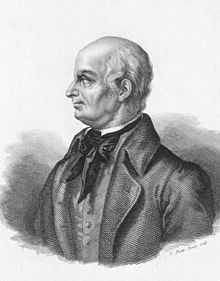
Back لادزارو سبالانساني Arabic لازارو اسپالانزانی AZB Ладзаро Спаланцани Bulgarian Lazzaro Spallanzani Breton Lazzaro Spallanzani Catalan Lazzaro Spallanzani Czech Lazzaro Spallanzani German Λάζαρος Σπαλαντζάνι Greek Lazzaro Spallanzani EML Lazzaro Spallanzani Esperanto
Lazzaro Spallanzani | |
|---|---|
 | |
| Born | 12 January 1729[1] |
| Died | 11 February 1799 (aged 70) |
| Nationality | Italian |
| Alma mater | University of Bologna |
| Known for | Digestion Animal fertilisation Discrediting spontaneous generation Animal echolocation |
| Scientific career | |
| Fields | Biology |
| Institutions | University of Modena and Reggio Emilia University of Pavia University of Padua |
Lazzaro Spallanzani (Italian pronunciation: [ˈladdzaro spallanˈtsaːni]; 12 January 1729 – 11 February 1799) was an Italian Catholic priest (for which he was nicknamed Abbé Spallanzani), biologist and physiologist who made important contributions to the experimental study of bodily functions, animal reproduction, and animal echolocation.[2] His research on biogenesis paved the way for the downfall of the theory of spontaneous generation, a prevailing idea at the time that organisms develop from inanimate matters, though the final death blow to the idea was dealt by French scientist Louis Pasteur a century later.
His most important works were summed up in his book Experiencias Para Servir a La Historia de La Generación De Animales y Plantas (Experiences to Serve to the History of the Generation of Animals and Plants), published in 1786. Among his contributions were experimental demonstrations of fertilisation between ova and spermatozoa, and in vitro fertilisation.
- ^ Annals of Medical History. P.B. Hoeber. 1924. p. 177.
- ^ Gacto, M. (1999). "The bicentennial of a forgotten giant: Lazzaro Spallanzani (1729-1799)". International Microbiology. 2 (4): 273–274. PMID 10943424.